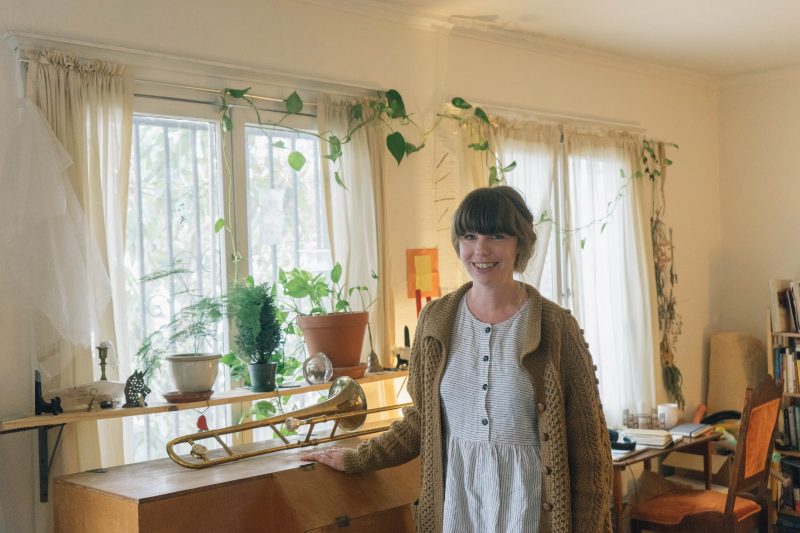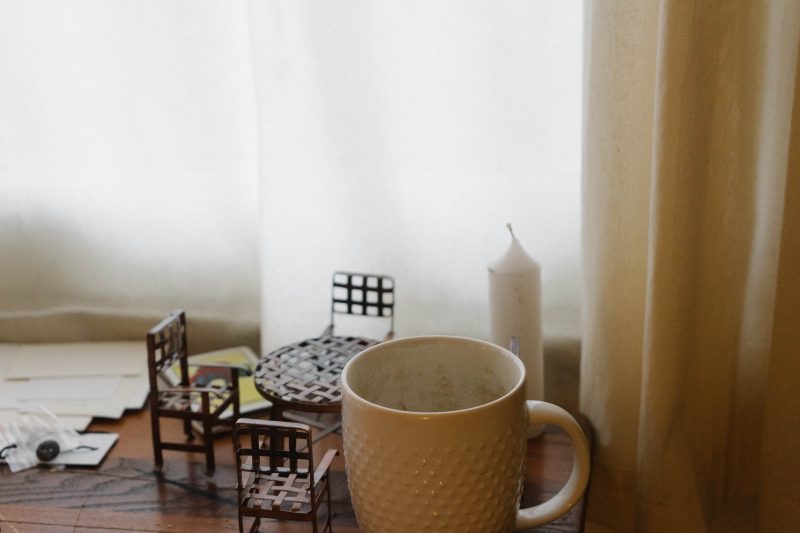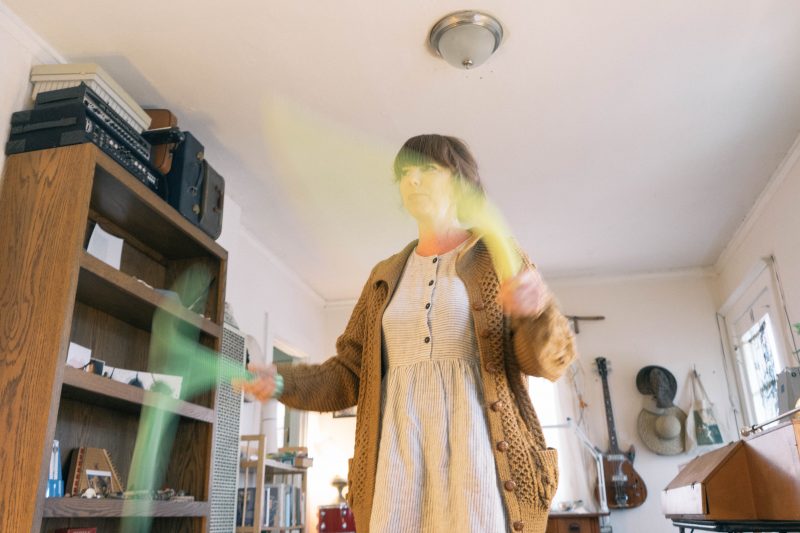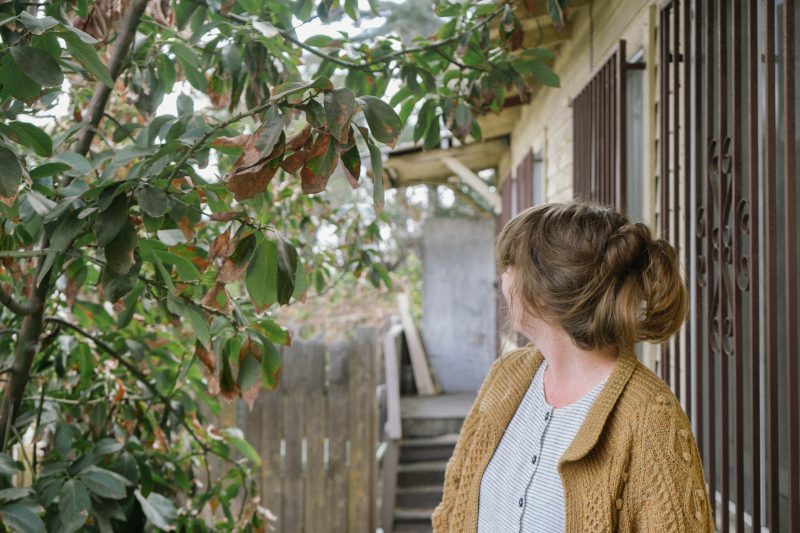
Laura Steenberge is a particular artist. Her work is defiantly her own. She makes choices and follows impulses. She sings, plays contrabass, viola da gamba, piano, guitar, and her own invented instruments. She does all of these very well. As a thinker, she programs and hosts her own genre-bending radio show for NTS Radio (The Imaginary Music Radio Hour, a monthly show “about music, mythology, and shapes”); she gives performative lectures to her concert audiences; and she teaches in the Experimental Sound Practices department at CalArts in Valencia, CA.
Although her work is multifaceted, Steenberge isn’t hard to get a sense of before seeing the bigger picture. Instead, her process is so uniquely her own that any given piece seems aptly representative of the whole. Each contains a clue that will help you garner more from the next, not quite the whole on its own. As we move in, the dots draw together and reveal more that we hadn’t seen: more depth, more humor, and more wonder.
So maybe we start as broadly as we can. “Lecture on Musical Form” is a 2014 blog post on Steenberge’s site. This lecture consists of little more than 200 words. It also has nine photos and a seven-minute video demonstration. In the video, Steenberge uses paper, scissors, a balloon, and a recorded rendition of Olivier Messiaen’s Monodie to teach us about musical perception. Before this, however, a few things happen: music becomes a cabbage, a cabbage becomes a stamp, and, lastly, a roll of paper—crumpled and cut—convincingly stands in for that cabbage-stamp. This, she argues, is how music works: “The form of music is difficult to fully comprehend due to the constraints of our experience of time.” Music is like a cabbage: we can process its immediate form but we skim over its granular features. The cabbage’s naturally complex geometric features are lost in the balled-up paper. This is to say that we understand and remember music based upon its broadest strokes.
Steenberge braces us for her video demonstration of form: “Music exists in a higher dimension with non-linear time. In this performance you will not experience the real piece; instead, you will see a warped 3D shadow-form and hear the warped shadow-sound.” That piece, Messiaen’s Monodie, is not to be directly experienced but instead observed secondhand. Steenberge essentially performs an eclipse of the piece so that she might shield our senses and help us observe it directly. It’s a reduction based upon the piece as she has perceived it: a rendition transposed from the knotty, intersubjective complications of interpretation. Taking the role of a critic, she is asking us to hear and see the piece as she had once heard it.

For Steenberge, shared listening always seems to be an opportunity for an exercise like this. (“How can I get the audience engaged without actually requiring some kind of commitment to participation? How can I convince them that there’s something they’re searching for in the piece and make it so that their mind is trying to find that thing?”) When Steenberge performs solo, she often presents several pieces as part of a single set. Before each piece, she tells stories (often pulling from classical myth, literature, and American culture) and guides our interest as an audience to a particular context for interpreting what we will hear. In one of these sets she accompanied her own voice by juggling a small ball.
As she tossed the ball from hand to hand, anticipating the pulse each landing would make, she inhabited the role of King Midas. We watched as her hands turned red and the ball turned gold. Red paint transferred from ball to hand, and the golden tissue paper with which she covered her hand now surrounded the ball. The effect was staggering but simple. “I call them humble objects,” she explains to me as we walk about the suburbs surrounding CalArts. “The humbler the better,” she continues. “If they have too much identity of their own then you can’t map that impossible imaginary thing on it. It has to be just barely existing. Just a scaffolding for the imagination.”
As we spoke, walking, we made a large loop. We crossed over the 5 freeway twice, a mile apart. Around the time of the latter crossing, I asked her—the freeway roaring under my voice—about a piece for which she used nothing more than a can of compressed air and a harmonica. As I’d remembered it, the sound of these two objects together—a small cacophony—represented the winds that blew the Odyssey against its course of sail. I didn’t remember much more about the specifics of that tale at the time of our conversation, but I did remember the sound itself as she’d presented it. I remember it as a sound (a frantic, microscopic flurry of notes) that I hadn’t thought a harmonica could produce. I remember that the smallness of it all was funny. Pocket-sized transcendence.
As it turns out, this wonderful sound wasn’t necessarily representing the bag of wind I’d ascribed it to. She corrects me, “I would say it moreso represents divine wind or divine breath. There’s this word pneuma. Like pneumatic tubes. It’s this really old Greek word that kind of means spirit and breath at the same time.” She tells me that the concept of the divine is very important to her as it relates to and stands in contrast to our own experience of being in the world. The divine is, to Steenberge, “a way of extending the mind beyond what we currently experience and currently know.” It pushes us forward and expands our perception, reformulating our reality. She then reminds me that the audience was also invited to think about the story of Rip Van Winkle as we listened to this divine wind. Perhaps this was the sound to which he arose out of his twenty-year slumber now in the wake of the American Revolutionary War. By overlaying these two tangential referents, we, as an audience, were given an out. The simple gesture that followed—the activation of the compressed air upon the harmonica—could really be anything any of us chose. What mattered more was that, in looking for it, we had stretched our own listening: engaged and taken part in the writing of the myth.

Once, to a similar effect—this time with collaborators Heather Lockie and Caitlyn Conlin—Steenberge reproduced the event in which Orpheus out-sang the Sirens at sea to protect the Argonauts. Four whirly tubes (plastic corrugated hoses that are swung in circles to produce airy wind tones) invoked the Sirens, while Conlin’s voice carried out a reimagining of Orpheus’ song. In Steenberge, Lockie, and Conlin’s retelling, the song Orpheus selects is notably “Cruel Sister,” an English murder ballad with origins dating back to the 17th century. This is a song which has been re-sung, rewritten, and retold since its conception, revitalized throughout the centuries through endless variants and settings. The song’s horrific tale begins when two sisters step towards a river and, driven by sexual jealousy, the older pushes the younger in, drowning and killing her. This is the song—in this brilliant retelling—that Orpheus selects to conquer the Sirens. She presents the event as a heartbreaking defeat for the Sirens: a terrible irony dawns upon them as they fail to live up to the cruelty of the older sister; they are unable to draw their own victims to a similar fate at sea. Eventually, the Sirens (Steenberge and Lockie) yield to Orpheus (Conlin), dropping the eerie howls of their whirly tubes and humbly joining her in her song.
This epic restaging was done with acoustic instruments (no microphones either) in the intimate lamp-lit loft space that once housed the wulf. (a communal, non-profit organization and an incubator for experimental music in Los Angeles). Because of this, there is a way in which these recreations fail: knowingly designed for small audiences at experimental music dives, they do not quite live up to the drama and theatrics that might otherwise immerse us in the divine fictions of these myths. Instead these performances stretch our mind to hear and imagine impossible fictions in the simplest, most available sounds. When we do so, we take part in a process of internal composition which writers, readers, audiences, and musicians have engaged in for millennia before us. Steenberge explains:
When music shows up in myth, it has all these powers that music doesn’t have, very literally speaking. But music does have some kind of extreme hold on people’s minds. The way music fans feel about music and the need people have to hear it – how do you put that into words? Music can’t really lure you in and murder you, but that’s a pretty good way of metaphorically describing the power it has over people. … What’s interesting about [myth] as a source for musical ideas is that you can’t ever actually hear it.
Steenberge’s work is centered around the affect that arises by attempting the futile task of mapping impossible sounds. It’s the disappointment felt when we find that we have survived the Sirens’ song. This push and pull of expectation is the slapstick routine that invigorates her work.

Steenberge’s rather young Imaginary Music Radio Hour engages with this humor most directly. When asked by NTS to produce a monthly hour-long show, she felt that she was in no position to do so: “I don’t digest tons and tons of music. I miss out on a lot of really great music that happens just because my metabolism for it is really slow.” But Steenberge became optimistic when she could envision the show as a research project. “I like putting information together and I like performance-lectures: essay/lecture formats with musical information.” The result is a deadpan, new age, documentary talk show with mythical intentions and musical guests. Monologues, lectures, playlists, mashups, advertisements, interludes, and demonstrations commingle and create an unprecedented format for essayed thought.
Episode 3 of The Imaginary Music Radio Hour is about “secret songs”: songs that we never get to hear, but which are sung about in the songs that we do get to hear. In each episode, Steenberge pairs her theme with a specific shape (often chosen to help make sense of the material at hand). “Thinking in terms of shape is a nice way to not have to use language,” she tells me. The shape that helps us come to terms with these “songs about songs” is the tesseract. The tesseract is, as Steenberge puts it, “a four-dimensional cube” often represented in three dimensions as “a cube inside a cube with lines connecting the cubes.”
Steenberge’s thoughts about the tesseract and its possible musical embodiments feel pertinent to her own practice. It seems built-in to her own navigation through interpretation, reframing, and compilation. “One way of thinking about a musical tesseract,” she calmly informs us, “is to simultaneously imagine all of the variations of a song that have ever existed as though they are each different faces of the same multi-dimensional shape.” Steenberge overlays stories and flattens temporal divides but importantly retains cultural specificity.
This thought enlivens her early take on Messiaen’s Monodie (where we began), reminding us that what we experience of a work is our own and what we take from it is personal. It also carries us through the mythical contortions she achieved by overlaying the evidently flexible tales of the Sirens with that of the cruel sister. Through this, new meaning was generated, and we found sympathy for the Sirens.
Steenberge interviews the Sirens on the second episode of her show. “Legally, the sirens are not permitted to sing in a public forum,” she tells us, “but they are permitted to speak, so we have invited them here today to have a conversation.” When Steenberge asks the sirens (again voiced by whirly tubes) about the “incident with Ulysses,” they respond with incoherent but noticeably vulnerable airy wails. Steenberge tenderly responds, “Oh, you don’t want to talk about it. I understand, I really do… it must have been so devastating for you when someone heard your song and didn’t die.” She gently moves the conversation away.
Steenberge playfully reframes the story, sympathizing with the only beings within it who have rarely (if ever) been afforded their own subject-hood. Both myths—that of the Sirens and that of the two sisters from “Cruel Sister”—traditionally villainize women as envious and lustful temptresses. It is important to consider how such mythologizing has played a part in popular culture and in the careers of many female pop musicians via the sort of interviews that Steenberge is parodying (currently, following a highly campaigned “comeback” by Justin Timberlake—a new album and another shot at the Super Bowl halftime—I am thinking of Britney Spears and Janet Jackson, two villainized victims of events through which he has publicly triumphed). As such, Steenberge has not only contemporized these myths, but radically politicized them. She does not just retell myth. She often, ever so subtly, transposes it to her own position. She steps into it and attempts to undo it.
Steenberge shows us, however, that this is nothing new. She uncovers for us a small history of a long-familiar “song about a song.” The Rivers of Babylon text, as it is found in the Bible, has been regularly set to song since the Middle Ages. It is a song “about an unsung song” when Jewish exiles found themselves lacking the heart for melody at their capture by the Babylonians. Steenberge shows us how this tale finds new life with its adaptive meaning. It moves through the twentieth-century outsider experimentalist Harry Partch, giving him the lease to render this song un-singable. Most famous, however, is its reggae setting by The Melodians, which injects it with Rastafari terminology to make a call for justice under oppressive rule. Steenberge explores how several versions of this sung tale handle the necessary representation of this song within it that, according to lore, could not be sung. By drawing a line through points, she shows us how these stories become so flexible and so ambiguous that their meanings transcend difference. Steenberge explains to me that for these stories to exist “they have to be told by a person and there’s a lot of room for a symbiotic relationship.” Their forms and meanings become evident somewhere between the storyteller, the audience, and the story itself. And so, it’s worth considering where we find them now.

When I began working on this piece, I thought I’d render the rather intangible, inexplicable live performances of Laura Steenberge through poetic writing, total documentation, and complete recapitulation. I thought I could thoroughly convey my own experience of her work so that one needn’t see it for themself to know. I suppose I thought I could deliver her presence out from its necessary immediacy, help it transcend the small rooms to which it brings warmth or the headphones through which her voice feels so close. I suppose I thought the written word could provide a vessel, a neat tool for exposure.
But I know now that I was doomed to fail. If I can give you anything, it is a tale worth telling. If you can imagine a body of work that is a faithful composite of everything I told you (in addition to the many things in between that I couldn’t convey), you can write the remainder for yourself. And perhaps this exercise (this stretching of the mind) will be fruitful and it will help shed grace on the great deal of music you will never experience firsthand but will no doubt be told so much about. Perhaps the strengths of language and myth are in the way we interpret them. We find touch-points in these imprecise gestures, transmutable to so many dissimilar experiences because of the grainy, truncated images they deliver. We infer the spaces between their suggestions and perhaps we take them on, if they move us. “The only way you can tell these stories is through language.” Imagine a ghost appearing to us suddenly; it has always been present, but now we see it too. Interviewing the tesseract on her program, Steenberge relates, “I see, I think that makes sense, sometimes you seem to be popping in and out of existence from my vantage point, or layering multiple realities, but it feels unified and continuous for you.” Myths, stories, and ideas exist through language,
But it’s not any particular words. These concepts are so fundamental. … You can say, ‘this is the story that has part A and B,’ but then you find another version where those two elements are reversed. They’re just these building blocks of ideas. You can make a storybook for children or you can write out that story in lots of words. … The story is one sentence, but you don’t tell a story in one sentence, you have to elaborate it. So where does it exist? It doesn’t exist as that story, it’s this whole mode of communication.
This might be why Steenberge finds her sounds and her nondescript objects so useful for communication. They are hollow, abstract, and mutable. Words take form and cluster but the meaning within a sound changes with each sitting.
Early in our conversation Steenberge told me about an unlikely early musical fascination, “I loved learning how to improvise walking bass lines, it just consumed me for a little while,” she tells me with a certain earnestness. “To write out different lines and write out variations and just start riffing on that, recombining them in different ways … creating these cells in your mind but then, when you play it, you’re not actually playing anything you specifically wrote down. I feel like that’s probably a moment that has continued resonating with me since then.” Just like the abstract logic that gives meaning to the sequence of a walking bass, we make sense of our realities by sharing stories. I don’t know if Laura Steenberge is always moved by the template versions of the myths she delivers, but she is certainly moved by their process of motion. This process is the site of her intervention, the thrill of her work.
More from this issue